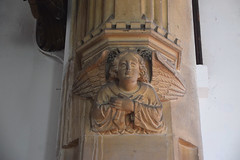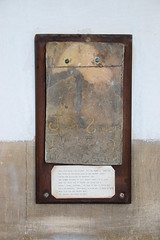| |
|
 |
|
Wangford village stretches
along a street which once carried the main London
to Yarmouth road. It must have been hell. Today,
the village is bypassed, and the road is a
peaceful little cul-de-sac of the loveliest 18th
and 19th Century houses, as well as a pub and a
shop. The village is not to be confused with the
ghost village of Wangford St Denis near
Lakenheath, on the other side of Suffolk.
The church sits on the southern side of the
street in as wide a graveyard as you can imagine.
It rises above the flat expanse, looking quite
unlike any other church in the county. The more
you look at it, the stranger it appears, like
nothing quite so much as a North London
Anglo-catholic creation of the 19th century,
decked out in flint and trimmed with Suffolk
features. And that is almost exactly what it is. |
The church here was, like most in
Suffolk, pretty near derelict by the mid-19th century. It
was all that survived of a Cluniac Priory, a cell to the
mother Priory at Thetford over the border, but must still
have been fairly substantial, even before falling under
the patronage of Henham Hall. The Hall, now gone, sat in
its park in the hamlet of Henham a bit to the south, on
the other side of the A12. It is best known today for the
Latitude Festival held in the grounds each summer. Henham
was within the parish of Wangford, and never had its own
church, and so it was that the Earls of Stradbroke,
owners of the Hall, set about memorialising themselves
here in Wangford church.
The architect was A. L. Blackburne. First, the whole
building was demolished apart for the nave walls. Next, a
tall beturreted chancel was added at the east end, and
beside it in the 1870s, a grand tower. Dallinghoo, to the
south, also has a tower at the east end, but that is
because it is a former cruciform church which has lost
its chancel and transepts. Here, the plan was deliberate,
and successful. The top of the tower was finished in the
14th century Suffolk manner. So it sits there at the east
end of the north aisle, while inside, the west end of the
nave has a huge window, which may possibly be the
refashioning of a tower arch. On the south side of the
church, massive flying buttresses support the nave wall,
perhaps necessarily or maybe just as an adornment.
Coming back here in 2017 after some fifteen years away, I
was struck by the sheer quality of what was done here at
Wangford. No expense was spared. I wandered around the
south side, where to my surprise I found the beeman
tending to hives in the south-east corner, moving
surreally among the headstones in his beekeeper suit. I
wandered around past what appears to be a Victorian
rector's garage to the east of the church, and in through
the north porch, which is the only other medieval
survival. Its remoteness from the tower gives the
illusion that you are entering the building from the
wrong end. It seems to have had a side sliced off it by
the buttress to the north aisle. You step into what, to
all intents and purposes, appears an urban church, but
one ruralised through the usage of the last century and a
half. Because of the width of the north aisle, the long
chancel appears offset in the south-east corner.
Either side of the chancel arch are
two curiosities, a reading desk and a pulpit. They are
said to have been brought here from the chapel at Henham
Hall, and to be 17th century Flemish. Perhaps they were
actually made out of Flemish panels taken from the Hall.
They are glorious affairs of inlaid wood and varnish,
with carvings reminiscent of ship figureheads buttressing
the corners.
An image niche on the south side of
the nave contains a memorial poppy from the Bloodswept
Lands and Seas of Red exhibit at the Tower of London
to commemorate a hundred years since the start of the
First Wolrd War. At the west end of the nave a simple
plaque of 1904 remembers Hilda McNeill, who lost her
life while attempting to save a little boy from drowning
in the Taw.
| The sanctuary is still
dressed in its ritualistic 19th Century pomp,
with a mighty gilded stone reredos. Suffolk
angels look down from the roof. Heaton, Butler
& Bayne's four light east window depicts the
Works of Dorcas flanked by St Peter and St Paul,
the parish patron saints. Some excellent glass on
the south side depicts two of the Holy Kinship,
with the Blessed Virgin reading scripture to the
young Christ on one side, and St Mary Cleophas
reading scripture to the young Saints Jude, Simon
and James on the other. It remembers Frederick
Charles Bonham, who died at the age of eight in
1863. Unfortunately, no one seems to know who it
is by. Clayton & Bell's early 20th Century
window of Charity and the Works of Mercy is a
little indifferent in comparison, but the 1880s
west window is strikingly different to all, one
of Suffolk's few windows by the Gibbs &
Howard workshop, depicting Christ clearing the
moneychangers out of the temple, Solomon building
the temple, and the ark of the covenant being
carried in the desert. All around, the walls are lined with
mementos to the Earls of Stradbroke, and as you
might expect they are all high quality. But there
is another memorial which is quite different. Up
in the sanctuary, there is a charming little
display of a tile inscribed with Jas Ife, Oct
5 1873 WANGFORD. It was recovered from the
chancel roof after a repair. a note below it
tells us that the 1871 census returns show James
Ife living in Wangford village, that he was
fifteen years old at the time he made the tile,
and that he gave his occupation as a brickmaker.
A rather different touchstone to the 19th century
than the huge, fine building that contains it.
|
|
 |
|
|
|